
Imagine a morning, a coming of winter morning when you exclaim, “Oh, my! It’s fruitcake weather!â€
Truman Capote did, and upon reading his story, “A Christmas Memory†for the first time about a decade ago, I never quite felt the same about Capote, Christmas or fruitcake.
I was always a Capote fan, ever since choosing his nonfiction classic, “In Cold Blood,†from a reading list in high school. The book, chronicling the 1959 murder of an entire Kansas family in cold blood, captivated me and gave me for the first time an awareness that, if a writer of Capote’s status took an interest in an event and the people of my home state, perhaps it could be a source of subjects for my own work.
I stumbled across Capote’s “A Christmas Memory†years later in an anthology of stories and essays about childhood. I had known that the young Capote had been abandoned by his mother, who left him in Alabama in the care of an eccentric older cousin named Sook.  Childlike and innocent, Sook gave Capote the heart that had been absent in his life, filling his days with rural adventures, as depicted in “A Christmas Memory,†along with other Capote works. In “A Christmas Memory,†the two – accompanied by a terrier named Queenie — spend days gathering ingredients to bake 30 Christmas fruitcakes to be sent out to friends and acquaintances across the country. They pick up windfall pecans from a neighbor’s grove, fill a yard-long grocery list of ingredients (candied lemon peel, citron, cherries, vanilla extract) bought with pennies they’ve accrued throughout the year and daringly procure whiskey from the foreboding proprietor of an off-the-beaten-path tavern. Along with making fruitcakes, they make the best of what they have for their Christmas together, fashioning decorations out of foil and construction paper for a tree they cut down themselves, and giving each other homemade gifts — paper kites they fly in a windswept meadow on Christmas day afternoon.
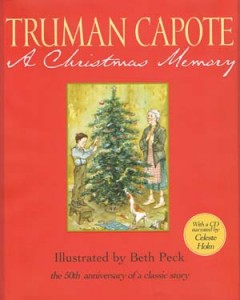 I’ve read very few works that have brought me to tears, but the first time I read “A Christmas Memory,†I wept. I still cry upon reading it, and have since discovered the 1966 film starring Geraldine Page that is also fodder for a good Christmas cry. I was thrilled to find a rendition of the story read by Capote himself.
I’ve read very few works that have brought me to tears, but the first time I read “A Christmas Memory,†I wept. I still cry upon reading it, and have since discovered the 1966 film starring Geraldine Page that is also fodder for a good Christmas cry. I was thrilled to find a rendition of the story read by Capote himself.
For the past two years, I have exclaimed, “Oh, my! It’s fruitcake weather!†(this year, I even marked it on my calendar) and the weekend after Thanksgiving, it is, as Capote described in his story, strangely birdless, quiet, not quite leafless (I am in California), but oh, yes, certainly the weather for fruitcake. I steep my fruit, chop my pecans, cream my butter, sugar, eggs and flavorings, then assemble the weightiness of the batter in a monstrous mixing bowl and fasten my seat belt for a long baking time and a good Christmas cry as I watch the film and hear Capote’s wispy voice (silenced by his death in 1984) narrate the story.
I love my new tradition, but I do feel I am a strange anomaly, baking fruitcakes. Even though the bright ingredients for fruitcake pop up in elaborate displays in the stores every holiday season, I’m the only person I currently know who makes these cakes.
Capote exalted his fruitcake to literary acclaim in one of his best-loved works. But fruitcakes themselves can inspire as much repulsion as affection. It seems you are a either a fruitcake lover or hater. Fruitcake is a bit of a holiday joke. It’s reputation and the near disdain many folks have for it comes from two things: it’s more-often-than-not heavy, leaden texture that when, produced in a bricklike form, resembles the peat loaves cut out of bogs that the Irish burn for fuel; and the decidedly unnatural — in both taste and appearance — presence of candied fruit. Fruitcake heaviness has turned it into a game – there are fruitcake-tossing contests every Yuletide. Some have found a practical use for those dense bricks – some years back Pee-wee Herman added a wing to his playhouse made out of fruitcake. And candied fruit is somewhat an oddity. It’s pretty, for sure, but it has been processed, colorized and digitally re-mastered to the point of neither looking nor tasting like any fruit it once was. In a bit Comedian Jim Gaffigan does on the mystery of fruitcake’s ingredients, he calls the fruit a “Skittle.â€
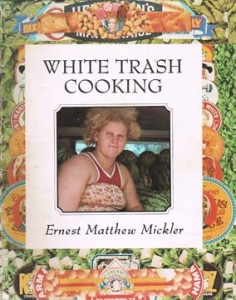 But if a fruitcake is homemade or made by a reputable company, it can be a rich and delicious holiday experience. I will now tell you, rambling as usual, how I came to sample my first homemade fruitcake. Some years back, I ran across a cookbook called “White Trash Cooking,†I had recently moved from Kansas to Venice Beach and, browsing through a bookstore some 100 yards from pounding ocean waves, I was missing the fields and folks of home. The book, with its greasy photographs and underclass charm, warmed my heart. I got a copy for myself and my parents, and a friend of theirs named Frank McHugh was so taken with the book, I got him a copy, too. Frank made nearly every recipe in the books (possibly even those containing squirrel), including “Mammy’s Fruitcake,†(too heavy for the post office, the book claims). I had some of the cake, and it was delicious, all the more savored by the fact that, despite this being a recipe by and for White Trash, Frank had spent some $28 on all the nuts, fruits and butter required for one cake.
But if a fruitcake is homemade or made by a reputable company, it can be a rich and delicious holiday experience. I will now tell you, rambling as usual, how I came to sample my first homemade fruitcake. Some years back, I ran across a cookbook called “White Trash Cooking,†I had recently moved from Kansas to Venice Beach and, browsing through a bookstore some 100 yards from pounding ocean waves, I was missing the fields and folks of home. The book, with its greasy photographs and underclass charm, warmed my heart. I got a copy for myself and my parents, and a friend of theirs named Frank McHugh was so taken with the book, I got him a copy, too. Frank made nearly every recipe in the books (possibly even those containing squirrel), including “Mammy’s Fruitcake,†(too heavy for the post office, the book claims). I had some of the cake, and it was delicious, all the more savored by the fact that, despite this being a recipe by and for White Trash, Frank had spent some $28 on all the nuts, fruits and butter required for one cake.
Last year, I decided to take my own stab at making fruitcake (as you can probably see by now, A Woman Sconed, cooks for the joy of the entire experience, along with the finished product). I had found Capote’s cousins recipe in “Sook’s Cookbook,†but the recipe required you to steam the cake for four hours, and the only thing I had large enough to steam anything was my bathtub and there, I would only steam myself! Also, even though I respected all that Capote and his cousin went through to find whiskey for their fruitcakes, I wanted one sans booze. So, remembering the White Trash recipe and the now-deceased Frank McHugh, I thought I would tackle that version.
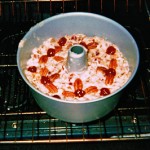 The first time I make a recipe, I usually follow it to the teaspoon. So, with “Mammy’s Fruitcake,†I incorporated the large amounts of candied fruits despite my misgivings about that ingredient. The batter nearly overwhelmed my largest mixing bowl and certainly wore out my arm, but during the three hours the cake baked in its tube pan, it perfumed the house with a buttery, intoxicating aroma.
The first time I make a recipe, I usually follow it to the teaspoon. So, with “Mammy’s Fruitcake,†I incorporated the large amounts of candied fruits despite my misgivings about that ingredient. The batter nearly overwhelmed my largest mixing bowl and certainly wore out my arm, but during the three hours the cake baked in its tube pan, it perfumed the house with a buttery, intoxicating aroma.
What made this cake good was not the colorful candied fruit (though decorative it was), but the equal proportion of pecans. Their nutty richness, along with a sizeable amount of butter, and a good dose of lemon and vanilla extracts, made the cake very flavorful. Hearty and heavy in a good way, a little slab will do ya.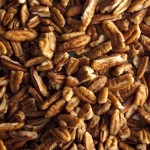 I began to think of ways to adapt the recipe to suit my own preferences, which would include dried fruits, rather than candied ones.
I began to think of ways to adapt the recipe to suit my own preferences, which would include dried fruits, rather than candied ones.
At my parent’s house last Christmas, I made my own version of the cake. I plumped raisins, dried cherries, apricots, dates, pineapple and cranberries in orange juice I heated in a saucepan. I also added the zests of an orange and a lemon and a whiff of cinnamon. The candied fruits are still present – they are, after all, a fruitcake tradition – but I used them sparingly in the cake and more as decoration atop it. The pecans – a whole pound of them – remain the same. I know they are pricey, but they make the cake.
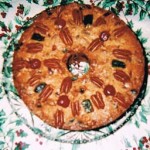
The cake is citrusy, the plumped fruits taste like fruits, the candied fruit lends that stained glass appeal, and a wedge of the cake, laden with nuts and butter, keeps you quietly chewing and reflective for a time – a moment of silence to honor baking and literary tradition. I’ll do it every year on a coming of winter morning.
So here’s to Frank McHugh and “White Trash Cooking; to Capote†and to “A Christmas Memory†of rich, heavy fruitcakes mailed out into the world and paper-light kites sent adrift into the sky.
Fruitful Fruitcake
(Adapted from “Mammy’s Fruitcake†in “White Trash Cooking†by Ernest Matthew Mickler)
5 large eggs
½ pound (2 sticks) butter
1 cup granulated sugar
1 ¾ cups flour
½ teaspoon baking powder
½ teaspoon salt
½ teaspoon cinnamon
2 cups candied cherries (red and green), chopped
3 cups dried fruits (raisins, pineapple, chopped apricots, sour cherries, cranberries, dates)
1 cup orange juice
Zest of one orange and one lemon
4 cups pecans, chopped
1 tablespoon vanilla extract
1 tablespoon lemon extract
Additional whole candied cherries and pecan halves for decoration
Combine orange juice and dried fruits in a saucepan. Heat to a simmer, turn off heat and cover pan to steep fruit. Let cool.
In a very large mixing bowl, cream butter and sugar until fluffy. Add well-beaten eggs and blend well. Toss nuts, candied fruit and cooled plumped fruit that has been drained with part of the flour (about ½ cup). Combine remaining flour, baking powder, salt and cinnamon. Fold into butter-and-egg mixture. Add zests and extracts and mix well. Stir in fruits and nuts, mix well by hand. Spread batter in a greased 10-inch tube pan or two 8-inch loaf pans and decorate top with whole cherries and pecan halves. Place in a cold oven. Bake tube pan for 3 hours (loaf pans for 1-1/2 to 2 hours) at 275 degrees. Remove cake and let stand until cool. Remove from pan.